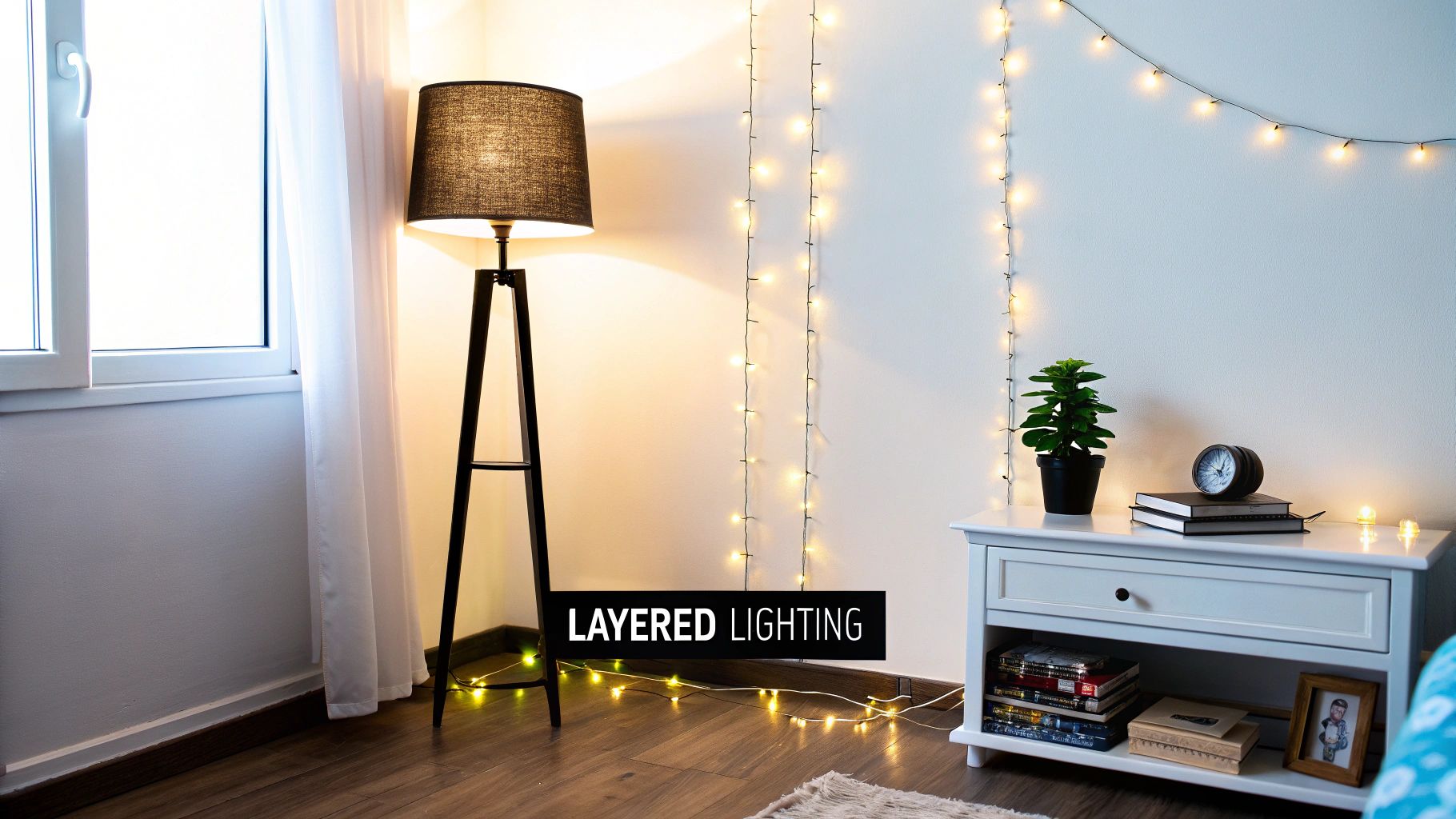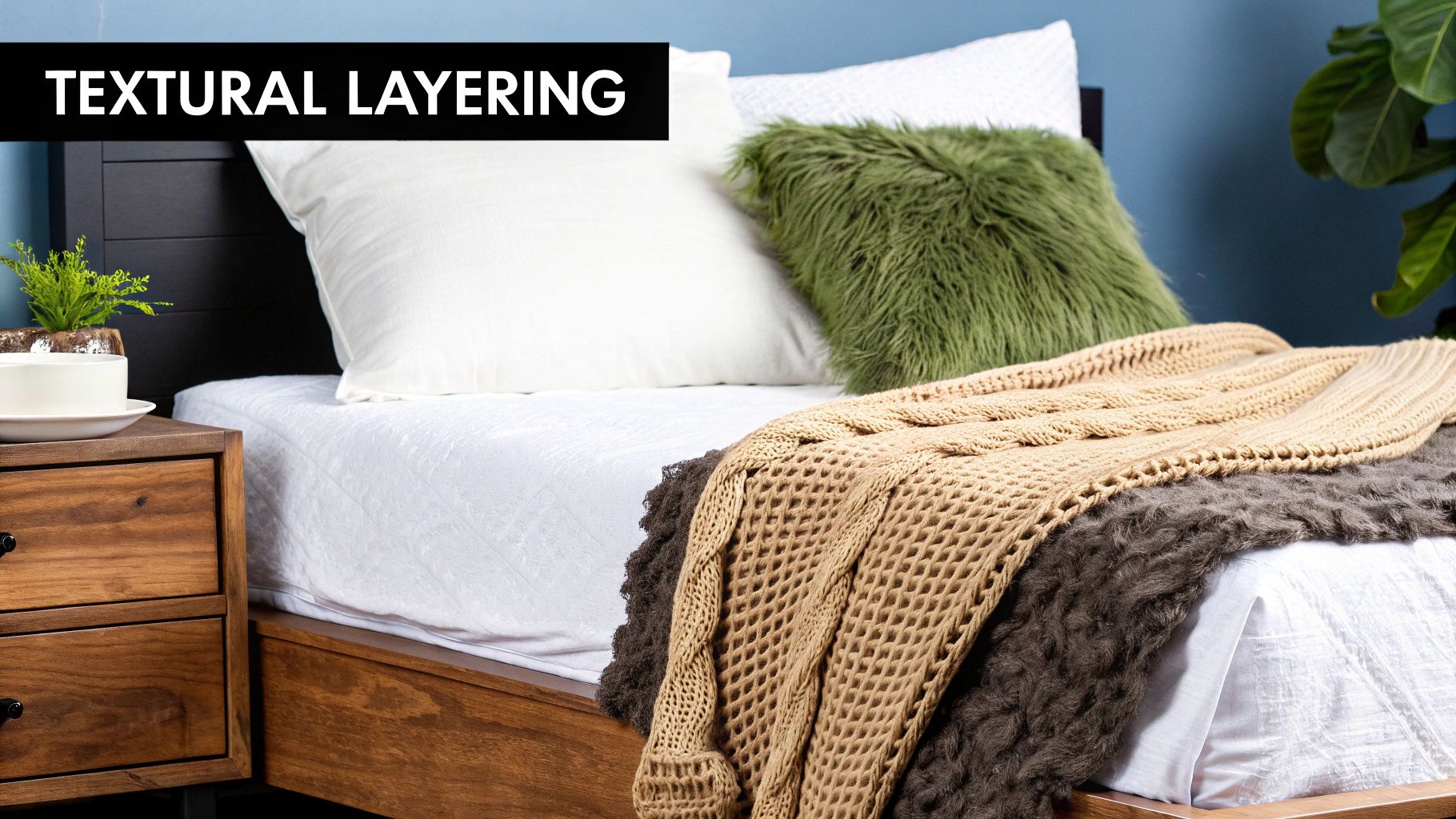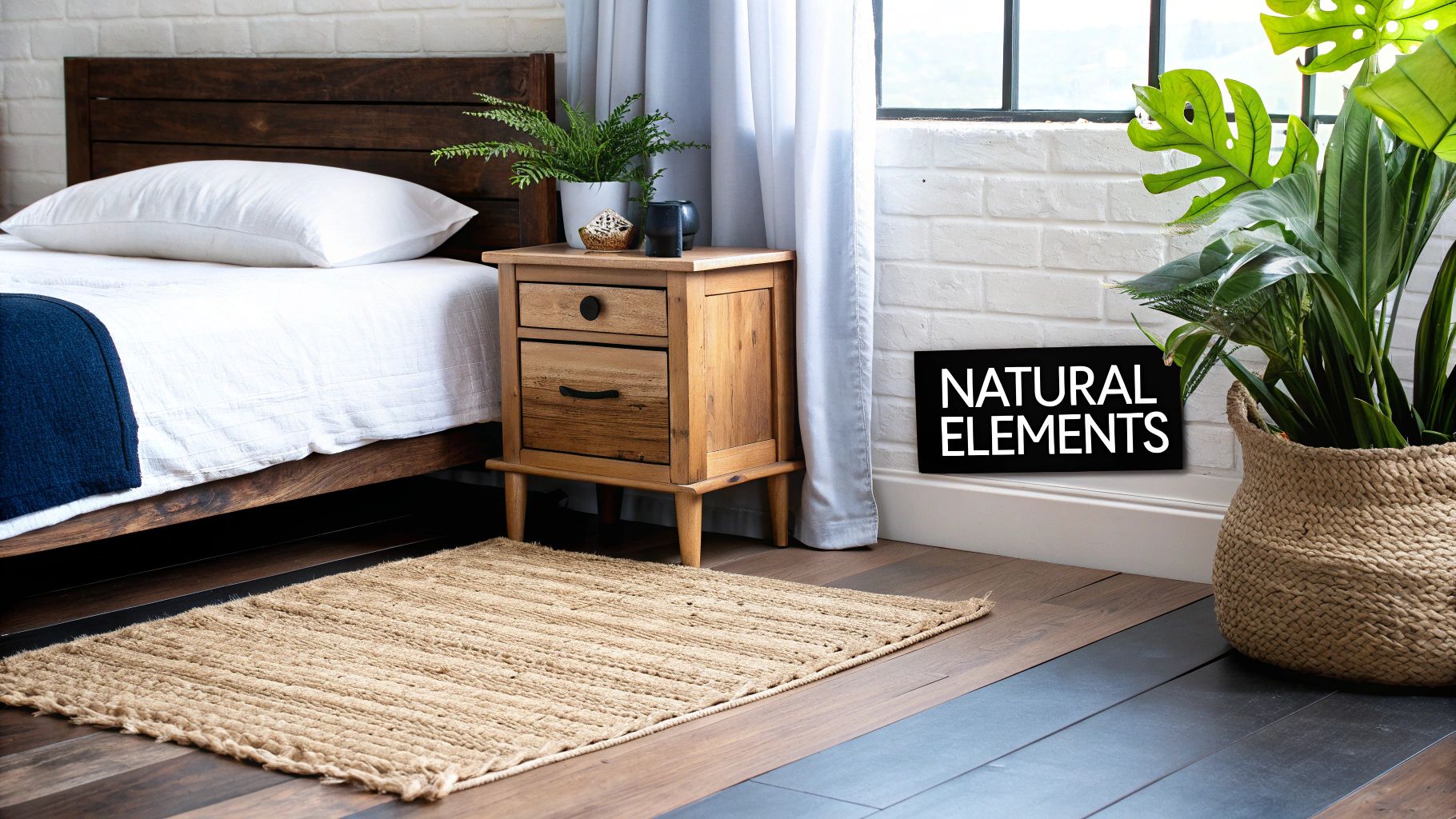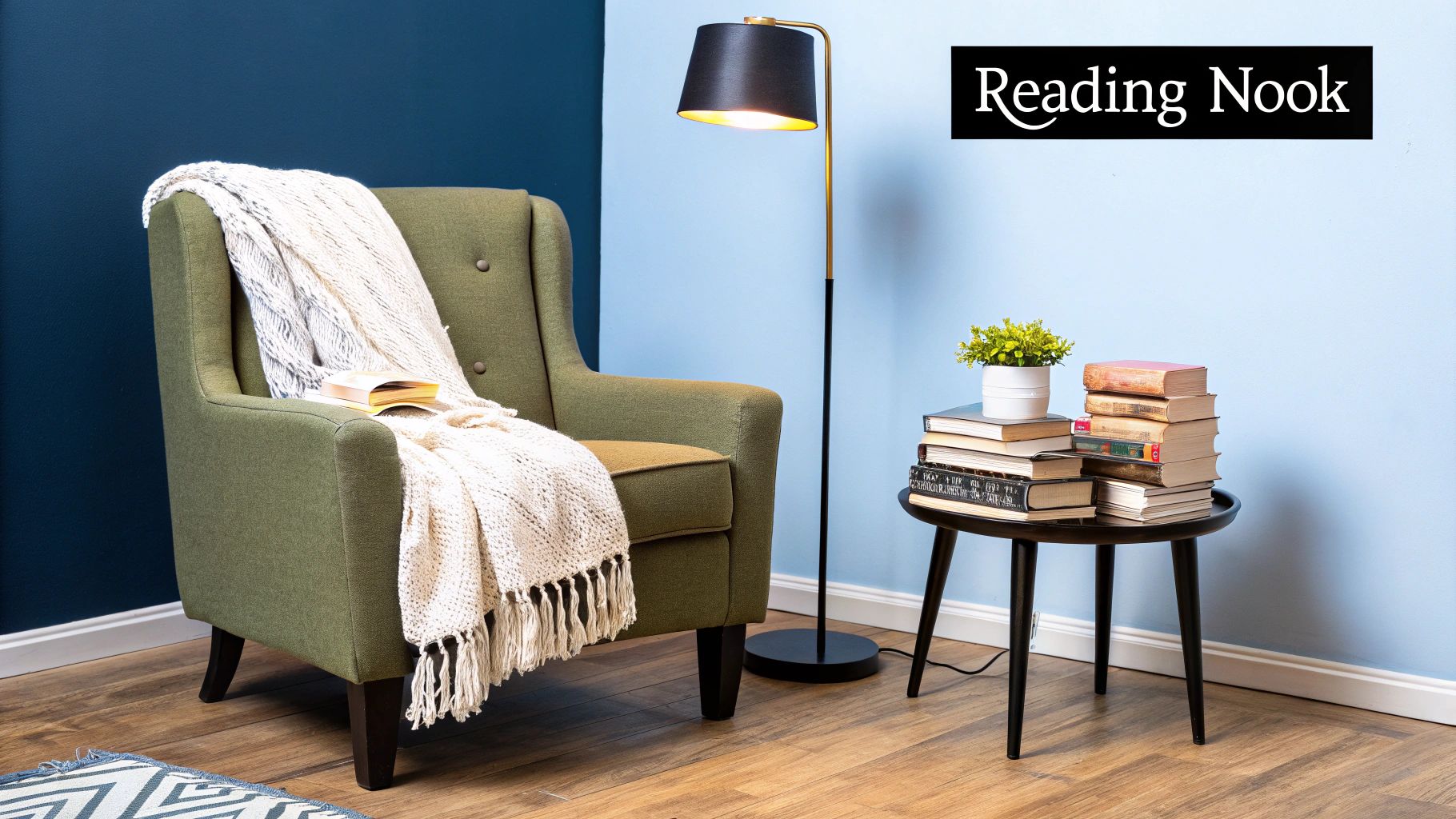A truly cosy bedroom is more than just a place to sleep; it’s a personal sanctuary, a space designed for rest, comfort, and rejuvenation. In our fast-paced world, carving out a haven that feels uniquely yours has become a necessity, a vital component of self-care. This article moves beyond generic advice to offer specific, actionable cozy bedroom ideas that focus on creating depth, warmth, and a complete sensory experience. We'll explore how integrating luxury textiles, thoughtful lighting, and personal touches can fundamentally transform your room from a simple sleeping area into the ultimate retreat.
With a focus on quality craftsmanship and curated homewares, you will learn how to masterfully layer textures and sophisticated colours to build a space that not only looks inviting but feels deeply restorative. This guide provides a clear roadmap, detailing how to implement concepts like layered lighting design, natural elements, and luxurious bedding to achieve a balanced and tranquil atmosphere. Get ready to turn your bedroom into the elegant, personalised sanctuary you deserve, a place where every detail contributes to your well-being.
1. Master the Art of Layered Lighting
Creating a truly cosy bedroom atmosphere begins not with furniture, but with light. It’s time to move beyond the single, often harsh, overhead fixture and embrace a layered lighting design. This interior design strategy uses multiple light sources at different levels and intensities to sculpt a space with unparalleled depth and warmth, a foundational step in crafting effective cozy bedroom ideas.

The approach combines three distinct types of lighting: ambient (overall illumination), task (focused light for activities like reading), and accent (light that highlights architectural features or art). By orchestrating these sources, you can transform your bedroom’s mood from bright and energising to soft and tranquil at the flick of a switch. Think of light as a material you can use to paint your room with atmosphere, much like the sophisticated schemes seen in boutique hotels or Scandinavian 'hygge' interiors.
How to Implement Layered Lighting
To bring this concept to life, focus on diversifying your light sources. A soft glow from a bedside lamp combined with the gentle flicker of candles or the artistic drape of festoon lights creates an instantly relaxing environment perfect for unwinding. You can learn more about styling with vintage-style festoon lights to add a whimsical yet sophisticated touch.
- Install Dimmer Switches: This is the single most impactful change you can make. Dimmers on your primary lights give you complete control over the room's brightness and mood.
- Choose Warm-Toned Bulbs: Always opt for bulbs with a warm, soft white glow (around 2700K) over cool, blue-toned ones to foster a sense of comfort and serenity.
- Use at Least Three Sources: Combine a ceiling fixture, bedside table lamps, and perhaps a floor lamp or a string of accent lights to achieve a balanced, enveloping feel.
2. Embrace Textural Layering
A truly cozy bedroom appeals to more than just the eyes; it engages the sense of touch. The art of textural layering involves thoughtfully combining different fabrics and materials to build a space that feels as good as it looks. This technique moves beyond colour and pattern, focusing instead on creating tactile depth with a mix of surfaces, from chunky knits and smooth cottons to rough-hewn wood and soft velvets.

This approach is central to creating sophisticated and inviting spaces, popularised by designers like Nate Berkus and seen in the curated seasonal collections of brands like Pottery Barn. It is one of the most effective cozy bedroom ideas because it adds a layer of richness and warmth that a visually flat design simply cannot achieve. By juxtaposing different materials, you create a dynamic environment that invites you to snuggle in and relax, making the room feel both luxurious and profoundly comfortable.
How to Implement Textural Layering
Start by thinking about how different materials feel. The goal is to create a delightful contrast that is both visually interesting and physically comforting. A plush velvet cushion against a crisp linen duvet cover, or a chunky wool throw draped over a smooth leather armchair, are perfect examples of this principle in action.
- Mix Rough and Smooth: Combine contrasting textures to create balance. Pair soft, plush materials like faux fur or velvet with more organic, rougher textures like linen, jute, or reclaimed wood.
- Vary the Scale: Incorporate a mix of textures with different visual weights. For instance, pair a finely woven blanket with a large, chunky knit throw and pillows with delicate embroidery to add complexity.
- Start with a Neutral Base: A neutral colour palette provides the perfect canvas for layering textures. Creams, greys, and beiges allow the different materials, rather than colours, to become the main feature.
3. Embrace a Warm Colour Palette
The psychological impact of colour is immense, and harnessing a warm palette is one of the most effective ways to cultivate an intimate, cocoon-like atmosphere in your bedroom. This approach moves beyond sterile whites and cool greys, instead favouring shades that evoke comfort and serenity. These colours absorb light rather than reflecting it, creating a softer, more subdued environment that is fundamental to crafting successful cozy bedroom ideas.

A warm colour scheme can range from deep, earthy tones like terracotta and ochre to muted pastels like dusty rose or even rich, enveloping jewel tones such as emerald or plum. The goal is to select colours that feel inherently welcoming and personal. Leading brands like Farrow & Ball and Benjamin Moore have curated collections that masterfully demonstrate how these hues can transform a simple room into a sophisticated, restful sanctuary. The warmth provides a perfect backdrop for layered textures and soft lighting.
How to Implement a Warm Colour Palette
Bringing a warm palette into your bedroom requires thoughtful planning to ensure the space feels cosy, not claustrophobic. Start by considering the room's natural light and then build your scheme with a balanced approach to colour distribution. This strategy helps create a cohesive and inviting space that feels both stylish and deeply personal.
- Follow the 60-30-10 Rule: Use your main warm colour for 60% of the room (walls), a secondary colour for 30% (bedding, curtains), and a cooler accent for 10% (cushions, art) to create balance.
- Test Colours Thoroughly: Paint large sample patches on different walls and observe them throughout the day. A colour's appearance can change dramatically with shifting natural and artificial light.
- Consider Room Orientation: North-facing rooms receive cooler light and benefit greatly from warmer tones to counteract the chill. South-facing rooms can handle slightly cooler shades within a warm palette.
4. Integrate Natural Elements
Bringing the calming essence of the outdoors into your bedroom is a powerful way to foster a sanctuary-like atmosphere. This approach, rooted in biophilic design, involves integrating organic materials and living elements to create a tangible connection with nature. By thoughtfully incorporating wood, stone, plants, and natural fibres, you can craft a space that feels both grounded and restorative, a cornerstone of any truly effective cozy bedroom ideas.

The philosophy is simple: humans have an innate tendency to seek connections with nature, and satisfying this urge indoors reduces stress and enhances well-being. Think of the serene feeling of a forest retreat or a coastal escape. You can replicate this tranquillity by using materials that evoke the natural world, from the rich grain of an oak bedside table to the soft texture of a jute rug. This isn't just about aesthetics; it’s about creating an environment that nurtures your senses and promotes deep relaxation.
How to Implement Natural Elements
The key is to layer natural textures and tones to build depth and warmth. Start with a foundational piece, like a wooden bed frame, and build from there with smaller accents. Adding greenery is particularly impactful, as it literally breathes life into the room. For more inspiration, you can learn more about styling with plants in the bedroom to create your own indoor oasis.
- Introduce Greenery: Choose low-maintenance plants like snake plants, pothos, or ZZ plants that thrive in lower light conditions. Mix live and high-quality faux plants for a lush look without excessive upkeep.
- Focus on Furniture and Finishes: Opt for furniture made from natural wood like oak, walnut, or rattan. Even small touches, such as a stone-based lamp or a wooden decorative bowl, can make a significant difference.
- Incorporate Natural Fibres: Layer textures with rugs made from jute or sisal, and choose bedding and curtains in natural materials like linen, cotton, or wool to enhance the tactile comfort of the room.
5. Carve Out a Dedicated Reading Nook
Transform a forgotten corner of your bedroom into a dedicated sanctuary for relaxation and literary escape. A reading nook is more than just a chair; it’s an intentional space designed to signal to your mind that it’s time to switch off, slow down, and immerse yourself in a good book. This concept of creating a distinct zone for a single, calming activity is a powerful way to enhance your room's functionality and amplify its overall sense of comfort, a cornerstone of effective cozy bedroom ideas.
Inspired by the curated aesthetic of "Bookstagram" influencers and literary-themed retreats, a well-designed nook acts as a visual anchor that radiates cosiness. It creates a secondary point of focus beyond the bed, adding depth and personality to your layout. By dedicating an area specifically to quiet contemplation, you are intentionally building a haven within your own home, making your bedroom a more versatile and restorative environment.
How to Create a Reading Nook
The key is to combine comfort, lighting, and function in a compact area. Position your nook near a window to take advantage of natural light during the day, and add a dedicated lamp for evening reading sessions. The goal is to make it an irresistible spot that invites you to curl up and unwind. You can find inspiration by browsing dedicated Pinterest boards or IKEA's room inspiration galleries, which often showcase clever use of small spaces.
- Choose the Right Seat: Select a comfortable armchair or chaise lounge that fits the scale of your room. It should be inviting without overwhelming the space.
- Add an Ottoman: An ottoman or footstool is non-negotiable for true comfort, allowing you to recline fully and relax.
- Include Smart Storage: Keep a small side table or a slim bookshelf nearby to hold your current read, a cup of tea, and perhaps a candle.
- Layer with Textiles: Drape a soft throw blanket over the chair and add a plush cushion for lumbar support to complete the inviting setup.
6. Create a Sanctuary with a Canopy or Curtain Bed Treatment
To elevate your sleeping space into a private, intimate sanctuary, consider enclosing it with fabric. A canopy or curtain bed treatment instantly creates a "room within a room," adding a touch of drama and romance while enhancing the feeling of seclusion. This technique is one of the most effective cozy bedroom ideas for physically cocooning yourself in comfort.
This design element transforms the bed into the room's undeniable focal point, fostering a sense of protection and tranquility. From the structured elegance seen in Restoration Hardware designs to the free-flowing drapes of bohemian styles, enveloping the bed with textiles softens the room's architecture and muffles sound, creating a peaceful micro-environment perfect for deep rest. The goal is to craft a personal retreat that feels both grand and incredibly snug.
How to Implement a Bed Canopy or Curtains
Whether you opt for a full four-poster frame or a simpler DIY ceiling-mounted drape, the key is choosing the right fabric and installation method. A flowing arrangement of linen or cotton voile can introduce a soft, ethereal quality, making the space feel like a luxurious hotel suite. For a more modern and minimalist approach, you can learn more about how to use ceiling-mounted curtain tracks to create a sleek, custom look.
- Choose Lightweight Fabrics: Opt for breathable materials like linen, sheer cotton, or voile. They drape beautifully without blocking light or inhibiting airflow, preventing the space from feeling stuffy.
- Ensure Proper Installation: If hanging curtains from the ceiling, ensure you use hooks and anchors rated to hold the fabric's weight securely. For a full canopy bed, ensure the frame is assembled correctly and is stable.
- Consider Washable Materials: Select fabrics that are easy to remove and launder. This is crucial for maintaining a fresh, clean, and hygienic sleeping environment.
7. Embrace the Charm of Vintage and Antique Furniture
To cultivate a truly personal and cozy bedroom, look beyond the showroom floor and embrace the stories held within vintage and antique furniture. Incorporating pieces with history adds a layer of character, warmth, and uniqueness that brand-new items often lack. This approach prevents your sanctuary from feeling sterile or overly curated, instead infusing it with a soulful, lived-in quality.
A weathered rimu tallboy, an ornate Victorian-era mirror, or a mid-century armchair each bring their own narrative and distinct aesthetic to your space. The gentle patina of aged wood or the subtle imperfections in an antique find contribute to a relaxed, welcoming atmosphere. This is one of the most effective cozy bedroom ideas because it builds a space that feels collected over time, reflecting a personal journey rather than a single shopping trip. Mixing these treasures with modern elements creates a dynamic, sophisticated, and deeply comfortable interior.
How to Introduce Vintage Pieces
Integrating older furniture is about creating a balanced dialogue between the past and present. A single statement piece, like an antique kauri headboard, can serve as a stunning focal point, while smaller accessories such as vintage lamps or art can add subtle hints of character. Start by exploring local antique shops, estate sales, or online marketplaces like Chairish for unique finds that speak to you.
- Mix and Match Eras: Don't be afraid to pair a sleek, modern bed frame with antique bedside tables. The contrast creates visual interest and a more authentic, personalised look.
- Prioritise Quality and Safety: When sourcing pieces, especially for a bedroom, check for stability and solid construction. For painted furniture, be mindful of its history and ensure it's free from old lead paint.
- Think Beyond Furniture: Vintage textiles, such as an old hand-stitched quilt or a Persian-style rug, can also add immense texture, colour, and a sense of history to the room.
8. Curate a Personal Gallery Wall
Transform a blank wall into a storytelling centrepiece by creating a personal gallery wall. This is more than just hanging pictures; it's about curating a collection of art, photographs, and meaningful objects that reflect your personality and experiences. A well-composed gallery wall introduces texture, colour, and narrative into your room, making it one of the most impactful cozy bedroom ideas for personalising your sanctuary.
This design element acts as a visual diary, surrounding you with cherished memories and inspiring aesthetics. The key is to blend different sizes, frame styles, and mediums to create a display that feels collected over time rather than purchased in a single set. From family photos and travel postcards to unique art prints, each piece contributes to a cohesive yet eclectic look that makes the space uniquely yours. To truly personalise your space and create a curated gallery wall, consider incorporating unique pieces such as abstract blue paintings for your home.
How to Build Your Gallery Wall
A successful gallery wall requires a bit of planning to achieve a balanced, effortless appearance. It’s a chance to turn personal mementos into sophisticated decor.
- Plan Your Layout: Before making any holes, arrange your frames on the floor. Play with the composition until you find a balance that feels right, then trace each frame onto paper and tape the templates to the wall to visualise the final result.
- Maintain Consistent Spacing: A key to a professional-looking gallery wall is consistent spacing. Aim to keep a gap of 5 to 8 centimetres between each frame for a clean, organised feel.
- Mix It Up: Combine various frame sizes, orientations (portrait and landscape), and even shapes. Weave in different elements like a small mirror, a textile swatch, or a sculptural object to add depth and interest.
9. Indulge in Luxurious Bedding Layers
The centrepiece of any bedroom is the bed itself, and nothing says ‘cosy’ quite like sinking into a sumptuous arrangement of luxurious bedding. This approach moves beyond a simple duvet and pillow set, embracing multiple layers of high-quality textiles to create a visually inviting and incredibly comfortable sleep experience, reminiscent of a five-star boutique hotel. This is one of the most impactful cozy bedroom ideas for instantly elevating your space.
Inspired by the curated looks of brands like Parachute Home and the signature comfort of luxury hotels, this method focuses on both the tactile feel and the visual depth of your bedding. By thoughtfully arranging different weights, textures, and sizes, you create an inviting nest that beckons you to unwind. The secret is to build the bed up, from the sheets to the final throw, making it look as good as it feels.
How to Style a Layered Bed
To achieve this plush, cloud-like effect, begin with a foundation of premium sheets and build from there. Focus on combining materials like crisp cotton percale with soft, breathable linen or a chunky knit throw for a rich sensory experience. This technique is fundamental to creating a bedroom sanctuary where you can truly switch off.
- Invest in Quality Sheets: Start with the layer closest to your skin. High thread-count cotton, bamboo, or pure linen sheets provide a superior foundation for comfort.
- Layer Different Textures: Combine a smooth duvet cover with a textured coverlet or quilt, and finish with a soft wool or cashmere throw draped at the foot of the bed.
- Use an Odd Number of Pillows: For a professionally styled look, arrange pillows in odd numbers. Try a trio of Euro shams against the headboard, followed by your sleeping pillows and a single decorative cushion at the front.
- Maintain a Cohesive Colour Palette: Stick to a harmonious colour scheme, using varying shades of the same colour or complementary tones to ensure the layers look intentional and sophisticated, not chaotic.
Cozy Bedroom Ideas Comparison Matrix
| Design Approach | Implementation Complexity 🔄 | Resource Requirements ⚡ | Expected Outcomes 📊 | Ideal Use Cases 💡 | Key Advantages ⭐ |
|---|---|---|---|---|---|
| Layered Lighting Design | Medium - multiple fixtures and dimmers required | Moderate - multiple light sources and controls | Cozy, intimate atmosphere with mood flexibility | Bedrooms needing warm ambiance and relaxation | Reduces eye strain, mood adjustable |
| Textural Layering | Low to Medium - selection and arrangement of fabrics | Low - fabrics, pillows, blankets | Adds visual depth and tactile comfort | Inviting, sophisticated bedrooms | Affordable, enhances comfort |
| Warm Color Palette | Low - mainly paint and decor choices | Low - paint, textiles, accents | Relaxing, intimate, timeless appeal | Rooms aiming for cozy warmth | Works well with natural light |
| Natural Elements Integration | Medium - acquisition of organic materials and plants | Moderate to High - plants, wood, stone | Stress reduction, nature connection, improved air quality | Biophilic design focused spaces | Improves air quality, calming environment |
| Reading Nook Creation | Medium - furniture and lighting setup | Moderate - seating, lighting, small furniture | Functional cozy corner enhancing room utility | Multi-functional bedrooms with space for relaxation | Adds functionality, encourages relaxation |
| Canopy or Curtain Bed Treatment | Medium to High - installation of frames and fabrics | Moderate to High - bed frames, fabrics | Intimate, private sleeping area with architectural interest | Bedrooms with high ceilings aiming for drama | Provides privacy, blocks light |
| Vintage and Antique Furniture | Medium - sourcing and possible restoration | Moderate to High - often costly and unique finds | Adds character, history, uniqueness | Vintage or eclectic bedroom styles | Environmentally friendly, unique pieces |
| Gallery Wall Display | Low to Medium - arranging and hanging art | Low - frames and artwork | Personalized, visually interesting focal point | Rooms needing personal expression | Highly customizable, inexpensive |
| Luxurious Bedding Layers | Medium - selection and layering of bedding textiles | Moderate to High - quality linens and pillows | Enhanced comfort and luxury feel | Bedrooms aiming for hotel-like bed experience | Improves sleep quality, visually appealing |
Your Personal Sanctuary Awaits
Creating a genuinely cosy bedroom isn't about following a rigid formula; it's an artful process of personal expression. Throughout this guide, we've explored a collection of actionable ideas designed to transform your space from a simple room into a nurturing, restorative sanctuary. The journey is about thoughtfully layering elements that speak to your sense of comfort and style, culminating in a haven that truly feels like your own.
The power of these cozy bedroom ideas lies in their synergy. While each concept can stand alone, their true magic unfolds when they are combined. The warm, inviting glow from a layered lighting scheme beautifully accentuates the rich textures of luxurious linen bedding. A carefully curated gallery wall adds a layer of personal history that complements the timeless character of a vintage armchair tucked into a quiet reading nook. It's this interplay of light, texture, colour, and personal meaning that elevates a bedroom into a deeply personal retreat.
From Inspiration to Implementation
The most important takeaway is that crafting your perfect space is a marathon, not a sprint. The most authentic and inviting bedrooms are curated over time, reflecting an evolution of taste and personal history. Don't feel pressured to implement all these ideas at once. Instead, identify one or two concepts that resonate most deeply with you and begin there.
Consider these starting points:
- Start with the Core: The bed is the heart of the bedroom. Investing in high-quality, luxurious bedding, as we discussed in the "Luxurious Bedding Layers" section, provides an immediate and impactful upgrade to your comfort. This single change can redefine the entire feel of the room.
- Focus on Atmosphere: If you're seeking an instant mood shift, begin with "Layered Lighting Design." Swapping a harsh overhead light for a combination of warm lamps, dimmer switches, and accent lighting can dramatically alter the ambience with minimal effort.
- Inject Personality: For those wanting to make the space uniquely theirs, creating a "Gallery Wall Display" or integrating meaningful "Vintage and Antique Furniture" are excellent first steps. These elements tell your story and infuse the room with soul.
Ultimately, the goal is to create a space that supports your wellbeing, a room you look forward to retreating to at the end of each day. By embracing the principles of texture, warmth, and personalisation, you are not just decorating a room; you are investing in your own rest and rejuvenation. Your personal sanctuary awaits, and the path to creating it is a rewarding journey of self-discovery and design.
Ready to build the foundation of your cosy retreat? Explore the exquisite collection of artisan-crafted linen bedding and timeless homewares at The Foxes Den. Discover the perfect pieces to begin your transformation and experience the unmatched comfort that only premium, natural materials can provide. The Foxes Den


